Japan has a series of what they call “Joyful Trains”, it’s the name given to a set of trains and rolling stock that is operated primarily for tourism, charters, and special events. One of those trains, perhaps the most famous is the Resort Shirakami Train. The Resort Shirakami runs from Hirasaki, Aomori to Akita, using the JR Gono Line. This train, with its higher-than-average coaches and larger-than-average windows, runs, a lot of the distance alongside the Sea of Japan. It stops for specific points of interest. It slows down for particularly scenic areas (and there are announcements that this is happening). There are cultural performances onboard. Taking a Joyful Train in Japan is truly a uniquely Japanese experience, and the Resort Shirakami is one of the best. Here’s our guide to taking the Resort Shirakami Train.
THIS POST MAY CONTAIN COMPENSATED AND AFFILIATE LINKS MORE INFORMATION IN OUR DISCLAIMER
The Resort Shirakami train runs from Akita to Aomori with 20 stops in between. The 235 kilometer journey (146 mile) takes about 5 hours. And there are usually 3 Resort Shirakami trains each day. This service uses the Ōu Main Line and the Gonō Line. It is covered on the JR Pass, and that can make for a pretty spectacular if long, day trip from Tokyo.
The Joyful Trains of Japan
Japan’s Joyful Trains are a series of trains and rolling stock where the entire journey becomes an adventure. Run by the JR Group, these trains, run on various JR lines around the country and focus on themes, fun, and exploring particular areas. These aren’t commuter trains, they’re trains specifically designed for the experience that you’re going to have on them. The Joyful Train concept goes back to 1960 when a dining car dating back to 1935 was converted into an “o-zashiki” train. These were Japanese carriages that were popular in the early Showa Period (1926-1989), during the reign of Emperor Hirohito. Original carriages had tatami mats and shoji paper screens on windows, rather like, you know, traditional ryokans. Japan Rail’s Joyful Trains are themed and run on particular routes, usually throughout the year. And this is about our rides on the Resort Shirakami Trains.
The Resort Shirakami Train
Using primarily the JR Gono Line this train is one of the first Joyful Trains of Japan. You’ll travel through one of Japan’s UNESCO World Heritage sites, Shirakami-Sanchi, where the ocean views of the Sea of Japan are spectacular.
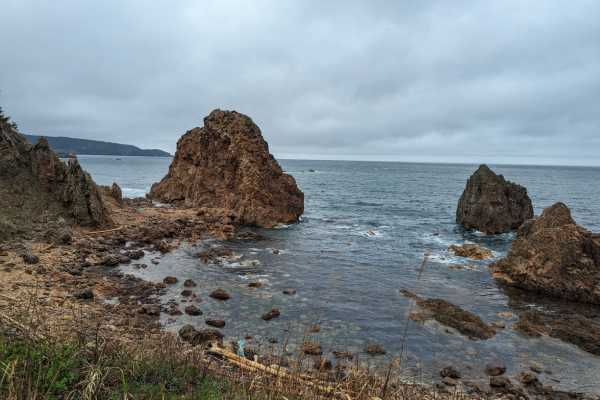
The Resort Shirakami Route
Japan Rail’s Resort Shirakami Train runs between JR Akita and JR Aomori and there are usually 3 trains a day in each direction. You can take the train from start to finish, and get off, or you can take a few stops in between – like this one at Juniko 12 Lakes – and explore some of the areas in which you’re traveling.
The Resort Shirakami Train Timetable
There are three Resort Shirakami Trains heading south each day and three heading north. If you book early enough (these are reservation only trains, you can’t just turn up and get on), then you can make multiple stops along the way and get the next train, after you’ve explored an area, like the Juniko 12 lakes for instance.
Resort Shirakami Train Design and Rolling Stock
It might confuse you when you’re trying to reserve seats on these trains to see that there are three different “types of trains”
- Buna
- Kumagera
- Aoike
They’re simply different carriage designs. Each train runs on exactly the same route and takes the same amount of time, it’s just that the design of the specific carriages is different. And they’ve taken inspiration from the natural area through which you’ll travel.

The Resort Shirakami train uses the JR Gonō Line and travels through the Shirakami-Sanchi UNESCO World Natural Heritage site. This area is a UNESCO site for several reasons – the ancient beech trees (buna), rare wildlife such as the black woodpecker (kumgera), and the lakes and ponds of Juniko Lakes, the most famous of which is Aoike.
And so the carriages take their design themes from those. Each of the train types has a self-service shop for buying snacks and drinks and there are also window counter seats (we sat at this for a while too). The trains have WiFi too and that’s free.
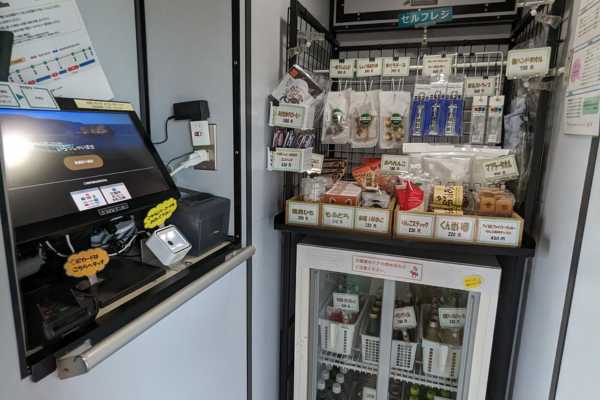
Resort Shirakami Buna Trains
The green exterior of the Buna (the Beech Trees of the area) trains represents trees and nature and the interior of the Buna trains uses a lot of wood, as the Akita Prefecture is famous for cedar wood. It’s also pretty bright with lots of pink, orange and yellow.

Resort Shirakami Kumagera Trains
Representing the black woodpecker that’s endemic to the area, this train is designed with a sunset in mind, the outside is orange and yellow and the deep red seats pay homage to the head of the woodpecker.
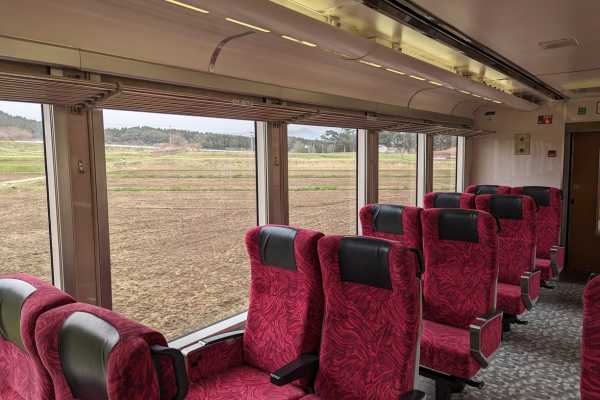
Resort Shirakami Aoike Trains
Finally, the Aoike, blue pond train is, well blue with interiors of grey and red.
Where’s the best place to sit on the Resort Shirakami Trains?
If you reserve your seats online then you don’t get a choice of seats, but they will be regular ones, not the booth-type compartments that are also available. These booth compartments are fabulous and if you go to one of the JR trains counters you can book one of them, if there is availability. The seats can be changed so that you can sit cross-legged, or even lie down. This is a great option if you’re traveling with a family or group.
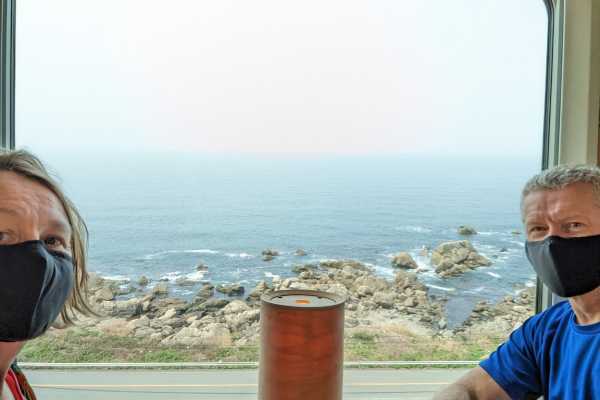
Other than that. Because of the large windows and the fact that this is a 100% reserved train, then I don’t think there’s a bad seat. You may end up sitting on the “non-ocean” side of the train, but it’s very easy to get up and walk around – even when the entertainment is on.
Each train runs with three carriages, meaning that there are around 110 seats available on each train depending on the carriage configurations.
What to See on the Resort Shirakami Train
Well for a start there are the views out of the windows. There are two places where the train makes a short stop (10-15 minutes). And then there’s the entertainment that is present on some of the trains too.

There’s often a shamisen performance. A shamisen is a traditional Japanese string instrument.
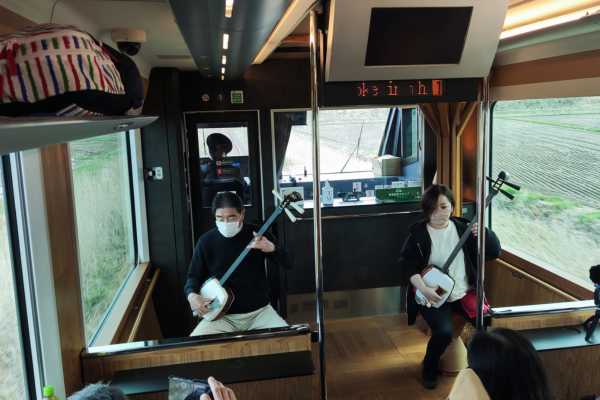
There’s also storytelling on this train in the local Tsugaru dialect and also puppet shows. There’s no translation (99% of our train were domestic tourists), but it’s great fun all the same to watch and to see everyone so engaged in it.
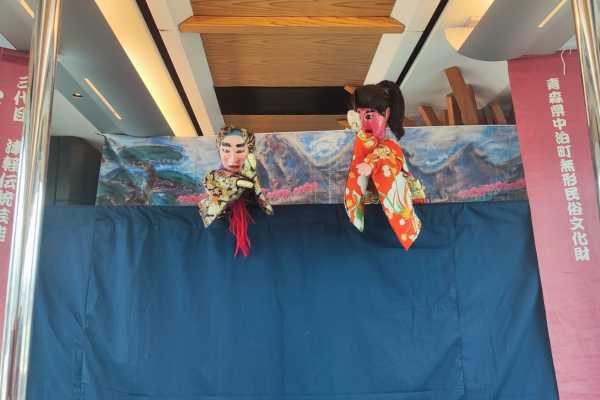
Station Stops of interest on the Resort Shirakami Train
The Resort Shirakami Train isn’t just a mode of transport, it’s an entire experience and so when you’re approaching a particularly nice viewpoint the guard will announce it, the driver will slow and you’ll have plenty of time to take photographs through the bigger than normal windows. There’s onboard entertainment and there are short station stops too. That’s right. The station staff organized specific events, for when these trains pull into the station. The stops are short – 10 minutes or so, but it’s well worth it. So grab your valuables, leave the rest of your gear on the seat, and pile off the train like everyone else. It’s GREAT fun.
These are the station stops of interest on the Resort Shirakami.
Noshiro Station
We had a 10-minute stop at Noshiro Station. Why? Well as the Noshiro Technical High School has won the Japan National Basketball Championships 58 times, they were chosen as the inspiration for the Japanese manga series “Slam Dunk”.
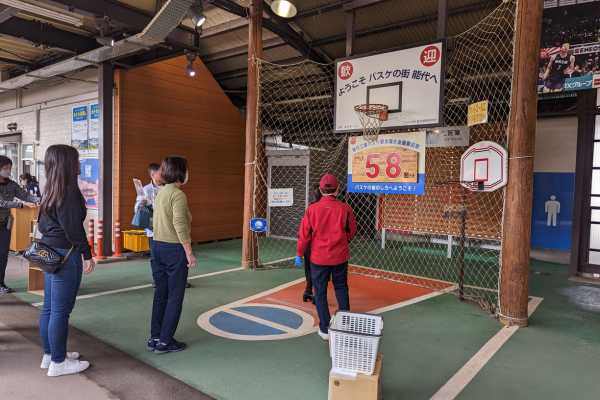
Now the staff at the station here have set up a basketball hoop and you can try and get the ball into it. You’ll get special (Resort Shirakami related) prizes if you do. On display, you’ll also see the uniforms of famous players.
Senjojiki Station
There’s also a 10 minute stop here at Senjojiki Station, and it could be that some people want to take photos of the coast here, but mainly, face it, we’re probably on this train because we’re train geeks, and so it’s a great opportunity to take photos of the Resort Shirakami that’s pulled in heading south. And compare what their carriages are like compared to ours.
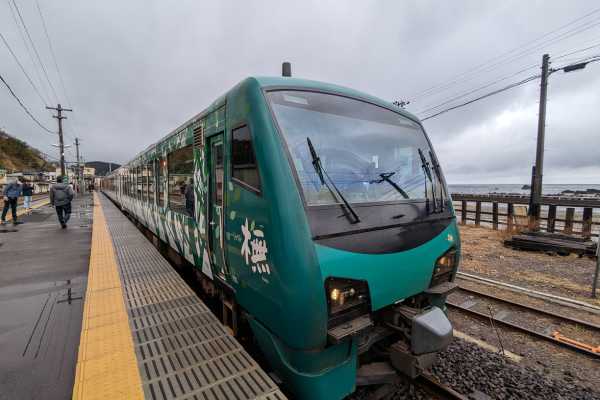
Not all the carriages are the same on the Resort Shirakami, our train was different on the way from Akita to Juniko, and then it was different again going from Juniko to WeSpa Tsubakiyama Station. And the train from WeSpa Tsubakiyama Station to Amori was again different. It’s a fabulous way to see the different trains and rolling stock.
Where to Stop on the Resort Shirakami Train
As well as the brief station stops that you’ll have on the Resort Shirakami that I described above, there are some specific stops, where it’s worth actually breaking your journey and spending some time, before catching another service to continue the journey.
Juniko 12 Lakes
The Juniko Lakes area is part of the Tsugaru Quasi-National Park area, and while there are 33 lakes, ponds, and water bodies here that were created in the aftermath of an earthquake in 1704, the area is named for the 12 bodies of water that can be seen from the summit of the nearby of Mount Okuzure. The most famous of the lakes here is Aoike – a stunning blue 9-meter (29.5 feet) deep pond. The Juniko 12 Lakes area is a 10-minute drive from Juniko Station. Plan to spend about 2.5 hours here at a minimum. Details of how to see the lakes are in my guide here.
Koganezaki Furofushi Onsen
The next stop along the line (if you’re heading north from Akita to Aomori) is JR WeSpa Tsubakiyama Station. And if you’ve broken your journey at Juniko Lakes, then this is a perfect place to take another stop. But make it an overnight one. While the Onsen does sell day passes, this is the perfect opportunity to spend the night in a ryokan onsen. (I wrote about Ryokans in my guide here ). The Furofushi Onsen is an open-air onsen RIGHT ON THE SEA OF JAPAN. Ok, enough shouting. It is really, right on the coastline. And seeing Furofushi means “never age and die”, that’s another good reason to come. As well as the (gender segregated) outdoor, right on the ocean onsens, there are also two inside onsens that you can use too. Rooms are both Western and Japanese style. And rates include a pickup and drop off from the JR WeSpa Tsubakiyama Station as well as breakfast and dinner. Want to know what its like? My Furofushi Onsen guide is here
BOOK A ROOM HERE
Stay at the Furofushi Onsen and choose from Japanese or Western Style Ocean Front Rooms. Furofushi Onsen rates include free pick up and drop off from the train station and breakfast and dinner, plus an ocean side onsen too.
We opted for a Japanese-style room, and I have to tell you that the futons here are remarkably comfortable, and going to sleep and waking up to the sound of the ocean is glorious, even if the weather was a little inclement. You’ll want to book your room early here, as they do sell out.
Hirosaki City
Ten stops further on is Hirosaki City, and while the Resort Shirakami Train only has two more stops to go, it’s well worth taking a break here as well, especially if you’re traveling between September and November. This area of Japan is famed for its growth of apples. That’s right. You’ll see the orchards as you trundle past in the train, but if you do travel during the fall, then stop off in Hirosaki, and head to Apple Park. With more than 80 varieties of apples, it’s a great place to come. The City’s Apple Park has a variety of festivals throughout the year (there are details here) and you can take a bus from JR Hirosaki Station to get there easily.
As we traveled through the Hirosaki area, the train staff, no doubt sponsored by the local tourism office brought round gifts of local apple juice.
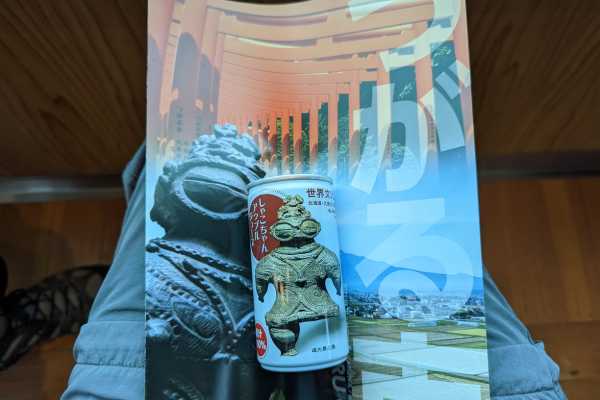
If you come out of season don’t worry, the city has you covered. A city and area that produces this many apples has to do something with them, so apple pie lovers are going to be in seventh heaven. The city tourism board has its own Apple Pie Guide Map.
Even if you don’t stop as you travel through you’ll see the apple orchards.

How to Book the Resort Shirakami train
The Resort Shirakami Train is 100% reserved seating only. Even if you’ve got a JR Pass. And you’ll need to make your seat reservations well in advance. If you’ve bought your JR Pass from Japan Rail themselves and are making online reservations, then you can’t specify what type of seat you want (i.e the normal ones of the “booth type”), but if you go to a JR Ticketing counter you can request the booth seats. And you’ll get them if they’re available. There’s no extra charge. We were just glad to get a seat on the train that we wanted.
When we traveled, the train wasn’t full on each of our legs, so we were able to walk around easily. And we sat in the booth seats for a while (as there was no one there), just to see what they were like. And, yes, definitely, if you’re traveling in a group or as a family, go for it they’re fabulous.
We also sat at the window counters in the café car for a while, because, heck why not?
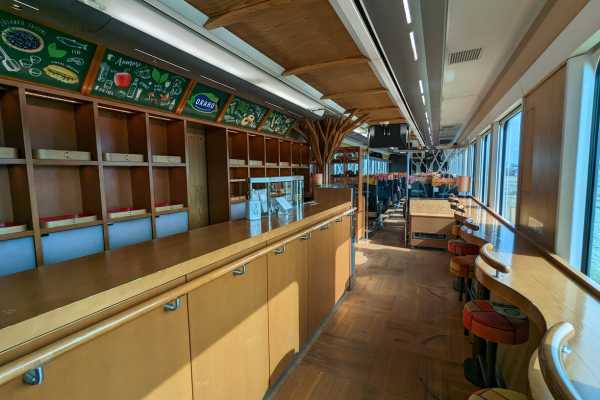
However, because of the large windows, there are fabulous views from everywhere on the train. You can even watch over the train driver’s shoulder too! (and I do recommend that for a while as well!)
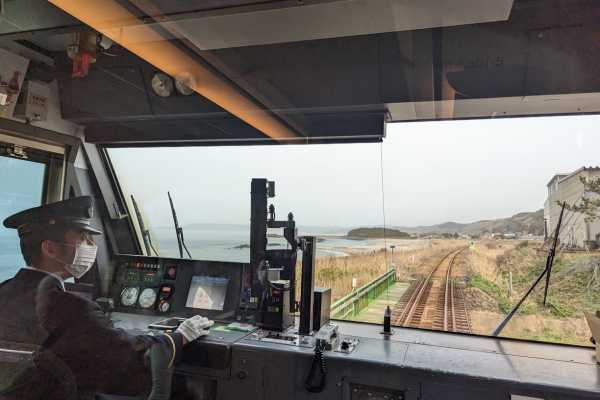
How to take the Resort Shirakami as a Day Trip from Tokyo
We did the Resort Shirakami as a two-day trip, starting from Akita, and stopping off at Juniko Lakes for a hike, then staying overnight at the Furofushi Onsen before continuing onto Aomori, where we then caught the train north to Hakodate and Sapporo. We used our Japan Rail Pass for this (my guide is here)
OPTION #1 BUY THE CHEAPEST JR PASS
Buy Japan Rail Pass from Klook
- Includes Worldwide Shipping
- Buy Regular or Business Class Pass
- Buy 7 day, 14 day or 21 day Japan Rail Passes
However, you can actually do this as a day trip from Tokyo. It’s a long day, but a heck of a trip. Here’s how to do the Resort Shirakami as a day trip from Tokyo.
06:32 Hayabusa from Tokyo to Shin Aomori (this arrives at 13:04) – Book this train here.
13:51 Resort Shirakami from Shin Aomori to Akita (arrives at 18:57)
19:10 Akita to Tokyo (arrives at 22:57) – Book this train here
This is a great way to get the value of the JR Pass done and dusted in almost a single day. If you buy all three tickets independently, the cost will be approximately US$278. A Japan Rail Pass for the whole country for 7 days costs around US$343.
Travel Tips for Exploring Japan
- Considering travel insurance for your trip? World Nomads offers coverage for more than 150 adventure activities as well as emergency medical, lost luggage, trip cancellation, and more.
- Get online immediately with an eSIM for Japan
- Take the right POWER ADAPTER to Japan
- Download and install a VPN BEFORE you travel to Japan > discount coupon here
- Read our guide to the Japan Rail Pass here
- Buy your Japan Rail Pass before you arrive in Japan
- You can buy JR Passes from Klook > check details here
- Or buy JR Passes from JRailPass here with delivery in 24-48 hours (including to your hotel in Japan)
- Book the best tours and guides in Japan on, GetYourGuideand Klook
- Want to know what its like at a Maid Cafe?
- Read about experiencing Sumo Practice in Japan
- Read about staying in a Ryokan town in Japan
- Learn to cook Japanese food in Chef’s kitchens in Japan
- Read about ATM fees in Japan here.
- Save money in Japan with a Wise debit card
- Find the right accommodation for you via Booking.com
- Book an incredible ryokan experience in Japan
Final Words on Riding the Resort Shirakami Train
As soon as we read about Japan’s Joyful Trains we wanted to ride one. And then we found the Resort Shirakami and managed to combine hiking in the Tsugaru Quasi-National Park, staying at the Furofushi Onsen, and getting us up to Aomori on our planned trip to Wakkanai. Perfect. This is a truly unique Japanese experience and really one to add to your bucket list.
We receive a fee when you get a quote from World Nomads using our affiliate links. We do not represent World Nomads. This is not a recommendation to buy travel insurance.
ASocialNomad is a participant in the Amazon Services LLC Associates Program, an affiliate advertising program designed to provide a means for sites to earn advertising fees by advertising and linking to amazon.com, amazon.co.uk, and amazon.ca. Amazon and the Amazon logo are trademarks of Amazon.com, Inc. or its affiliates. As an Amazon Associate, I earn from qualifying purchases.


